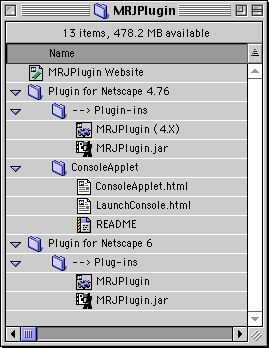MRJ Plugin for Netscape 4.X
Introduction
The MRJ plugin enables current Netscape browsers (version 4.X and later) on Mac OS to use the MacOS Runtime for Java (MRJ) to run Applets.
Netscape version 4.76 can run applets directly using the MRJ plugin. This feature can be turned on by opening up the preferences dialog (Edit -> Preferences -> Advanced), and checking the "Use Java Plug-in" checkbox.
MRJ 2.1 (or later), which is required to run the plugin, can be downloaded from Apple's Java Web Site.
Using the MRJ Plugin
Since Netscape 4.76 can run the MRJ plugin directly, there is no need to alter your HTML content to run applets. Features such as LiveConnect (calling Java from JavaScript) aren't supported yet.
For earlier versions of Netscape browsers, the MRJ plugin must be invoked using an EMBED tag, in a similar manner to Sun's Java Plugin, which enables the JRE to be used to run Applets on Windows and Unix Systems.
An APPLET tag that looks like this:
<APPLET BORDER = "5" WIDTH = "200" HEIGHT = "200" ARCHIVE = "AppletClasses.jar" CODE = "TrivialApplet.class"> <PARAM NAME=URL VALUE="http://home.netscape.com"> </APPLET>
must be rewritten to use the EMBED tag:
<EMBED TYPE = "application/x-java-vm" NAME = "TrivialApplet" PLUGINSPAGE = "http://www.mozilla.org/oji/" BORDER = "5" WIDTH = "200" HEIGHT = "200" ARCHIVE = "AppletClasses.jar" CODE = "TrivialApplet.class" URL = "http://home.netscape.com">
The EMBED tag has the following additional attributes:
- TYPE - this is the MIME type of the plugin, which must be "application/x-java-vm"
- NAME - this is the JavaScript name of the EMBED Tag instance
- PLUGINSPAGE - this is a URL that points to an web page that refers to this plugin. This helps the user find the MRJ plugin if it is not installed.
The rest of the attributes of the APPLET tag are given the same name in the EMBED tag. A PARAM tag is converted by adding an attribute to the EMBED tag whose name is the value of the PARAM tag's NAME attribute, and whose value is the value of the VALUE attribute. If there are name conflicts between the parameters and attributes, there will eventually be a substitution mechanism where parameters prefixed with "java_" will be passed to the applet with the prefix removed. This hasn't been implemented yet.
Security
The Plugin uses the standard Applet security model provided by MRJ. Remote applets can only open sockets with the server they come from, and only local applets can access the file system. There is no support for the Netscape security model, nor for signed applets, except through normal MRJ/JDK security mechanisms.
Limitations
- For Netscape browsers (versions < 4.76), you must use the EMBED tag instead of the APPLET tag.
- If your HTML page also has an APPLET tag (for compatibility with other browsers) then users should disable the built-in Java that comes with the Netscape browser.
- LiveConnect capabilites between JavaScript and Java do not work with Applets that are run using this plugin.
Installation Instructions
1. Download the MRJ Plugin. Your browser should automatically unstuff the file "MRJPlugin.sit.hqx" as the folder "MRJPlugin."
2. Open the "MRJPlugin" folder, and choose "as List" from the "View" menu in the Finder. You'll see the following items:

3. For 4.X browsers, move the files "MRJPlugin (4.X)" and "MRJPlugin.jar" from the "--> Plug-ins" folder in the "Plugin for 4.X" folder, to your browser's "Plug-ins" folder. To install in the Netscape 6 browser, move the files "MRJPlugin (4.X)" and "MRJPlugin.jar" from the "--> Plug-ins" folder in the "Plugin for Netscape 6" folder, to your browser's "Plug-ins" folder.
4. Installation is now complete. You can test your installation by going to your favorite applet on the internet, or by opening the console applet with "LaunchConsole.html" which is in the "ConsoleApplet" folder.
Checkout and Build Instructions
The source code is located in the CVS module 'mozilla/plugin/oji/MRJ' in the Mozilla tree. Look here for directions on how to check out the Mozilla tree (note: instead of specifying 'SeaMonkeyAll' as the module name, use 'mozilla/plugin/oji/MRJ'). Once the code is checked out, see 'mozilla/plugin/oji/MRJ/documentation/build-instructions.html' for more specific build instructions.
The MRJ Plugin is also built as part of the current Mozilla source, so you can also save yourself some time by grabbing a complete source image, which will include the MRJ Plugin source.
Bugs?
Don't hestiate to file bugs in Bugzilla, under the OJI component.
Release History
31 October 2000
Version 1.0b2 uses the browser's built-in networking capability for http and https URLs. This provides a lot more compatibility and has been a frequent feature request.
24 October 2000
Version 1.0b1 provides better support for clipping and loading applets from interesting codebases.
3 August 1999
Version 1.0d9 now supports Applet printing. Printing of top-level frames must be managed by the applet itself.
14 June 1999
Expanded the set of MIME types used to load the plugin to include "application/x-java-applet", and "application/x-java-applet;version=1.1.1" for better compatibility with Sun's Java plugin.
21 March 1999
Added full support for top-level Java frames (woohoo!). Events are handled by patches to WaitNextEvent and MenuSelect. Various other approaches were tried, this was found to be the most compatible.
Fixed CODEBASE processing hopefully for all cases. Please let me know if you find any problems with this.
Added support for a subset of the class
netscape.javascript.JSObject.
JSObject.getWindow() and JSObject.eval()
methods are partially implemented. JSObject.eval() only
returns String objects.
12 March 1999
Added "ConsoleApplet" which provides a simple Java console running as an applet. You can bring up the applet in its own window by opening "LaunchConsole.html." This applet is included in "MRJPlugin.jar" so you know longer have to install ConsoleApplet.jar in your "MRJClasses" folder.
This page last modified on 31 October 2000.